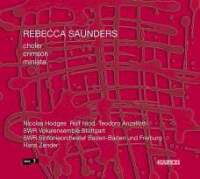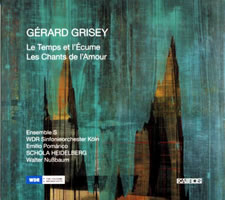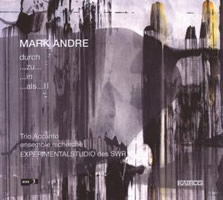|
Three from Kairos reviewed by Evis Sammoutis September 2008
Rebecca Saunders
KAIROS KAI 0012762
Track 1: choler for two pianos (2004)
Track 2: crimson for piano (2004-05)
Track 3: miniata for accordion, piano, choir and orchestra (2004)
Nicolas Hodges and Rolf Hind piano
Teodoro Anzellotti accordion
SWR Vokalensemble Stuttgart
SWR Sinfonieorchester Baden-Baden und Freiburg
Hans Zender conductor
Includes booklet with text by Björn Gottstein, James Saunders and Bastien Gallet
This CD offers a compelling insight into Rebecca Saunders's piano writing and a good indication of her recent aesthetic developments. Saunders is a composer who is increasingly gathering momentum and publicity and deservedly so.
The first work on the disc, choler for two pianos could be described as a study in intervallic tensions framed by silence. The series of closely spaced (and very often interlocking) clustered chords are in perfect interplay with various points of inaction that sometimes act as filters of tension whilst at others as continuation of the material. The material itself, in contrast to most contemporary works for piano over the last fifty years, uses very subtle extended techniques, and it is in its overwhelming majority played on the keys instead of the inside of the piano. Exploring aspects of timbre when writing for the piano is a very difficult task for any composer; Saunders employs various strategies that enable pitch / harmony to be perceived as colour, which makes this work all more effective and successful.
crimson for piano comes directly after choler, and if one does not check the CD player tracking list, then you would not have realize for a while that this is a different piece. The work creates a wonderful unity to the previous piece and is preoccupied with the same aspects of colour and pitch as described earlier. This link is even evident in the work’s title, showing Saunders’s connection with the work of James Joyce that has repeatedly served as a source of inspiration and reference in her work.
This work, nevertheless, creates much more complex textures (even if it is scored for a single player) and has more frequent alterations between pulsed and more abstract sound objects than the earlier work. There is also a more evident, clear vision of structure and hierarchy and shifts of foreground and background material and activity. In many parts there is almost a polyphony between the clearly defined actions of each sound object or gesture. Similarly to choler, a fundamental aural principle throughout is the way that the material is filtered and the actions decayed. This is achieved by using combinations of pedals, holding patterns within large clusters, mixing decaying sounds with other soft ones and stamping feet on pedal to produce unusually emerging, stunning sonorities, just to name a few. The atmospheric, quiet ending comes as a sharp contrast but an equally welcome change of mood and release of tension from the material highly charged in amplitude, density and texture of the previous sections of both pieces.
The most substantial work of the disc comes last. miniata is scored for accordion, piano, choir and orchestra. The work is structured in three movements and starts with wave gestures that gradually expand in all aspects so as to include all forces. The latter is typical of the first movement, yet again using silence to frame all events. Fragmented pulses recur here (on the high register of the piano that is so typical of Saunders’s works) and create a nice contrast to the less rhythmically defined clusters of sonority and colour that precede or proceed from these pulses. The solo piano and accordion create a wonderful counterpoint with the sparse orchestral colours and wordless choral sonorities. The chorus is very effective in helping define complex sonorities, and their sporadic use help accentuate certain colours all the more effectively.
The second section is characterized by the use of elaborate “Klangfarben” techniques, evolved in such a way as to serve the musical discourse. The choice of such a technique also helps to link aspects of colour and pitch even more effectively, resulting very often in the appearance of unconventional, unpredictable colours.
The third and final movement of miniata returns to the use of silence as an internal formal devise that helps punctuate both aspects of macro and microform. The focus here shifts; internal and external tempi decelerate considerably, and the two soloists become an organic part of the overall soundscape rather than the spearheads. The choir assumes a more major role and the quasi pointillistic sonorities acquire different representations. The “more physical” instrumental qualities and noises come into the foreground now aided by the thinning out of cluster spectrums.
The playing in all works is superb, helping to bring out all nuances and intriguing details of these three works. Saunders is a unique voice within the contemporary music circle, and this CD demonstrates nothing less. It highlights and embraces the composer’s compositional trends and trademarks in the best possible manner, especially within her writing for piano: the concise sound material, the economy of gestures and recurring sound techniques create an original and deeply personal style of expression.
Gérard Grisey
KAIROS KAI 0012752
Track 1: Le Temps et l' Écume
Track 2: Les Chants de l'Amour
Ensemble S
Paulo Alvares, Benjamin Kobler (synthesizer)
WDR Sinfonieorchester Köln
Emilio Pomárico (conductor)
Schola Heidelberg
Walter Nußbaum (conductor)
Gérard Grisey remains one of the most authentic compositional voices of the last century. His sudden and unexpected death ten years ago at the age of just 52 was a significant loss to the contemporary music scene and all those concerned with the development of the spectral music movement. Grisey’s influence extends to composers and theorists of all mediums. His pioneering scientific discoveries led to fascinating and deeply personal, emotional, musical results. The two substantial works on this disc are typical of his compositional oeuvres of the mid to late eighties and are preoccupied with the usual aesthetic, musical and scientific preoccupations of the composer.
That is especially the case with the twenty minute work Le Temps et l'Ecume, for four percussionists, two synthesisers and orchestra, the first piece on the disc. The work is characterised by an organic unity between the live and electronic sounds, creating a symbiosis between the two mediums. The latter could not have been achieved had the composer not attained a deep understanding of sounds through his frequent analyses of instrumental sonorities. The textures, spectrums and sonorities are typically Grisey, with lavish brass and high woodwind sounds whose spectrum is frequently punctuated by high metallic percussion. Brass crescendi with various kinds of mutes create breathtaking waves of sonorities and splashes of colour. Grisey’s music requires the utmost attention for detail, and most importantly, exact intonation and dynamics as indicated in order to fulfil his vision of unity between colour and pitch. The performance does not disappoint us. The playing is very precise and the balance remarkably well controlled.
For this work, the composer adopts new usages of time (which he would further develop in his later works) in contrast to his previous treatments: therefore, he is using three different time scales from three different sources here: human perception, bird temporal scales and whale song timings. The latter two could not be more contrasting: we perceive “bird time” as fast whilst the whale songs are typically slow. The orchestration of the work effectively underlines these three treatments. In many ways this piece is successful in creating multiple links between the composer’s personal preoccupations and his teacher’s (Messiaen) special affection for birdsong and demonstrates in the best possible manner that one of Grisey’s most effective achievements (beyond his pioneering use of electronics, live instruments and computer-assisted processes) lies in his deeply personal, “human” treatment of his material.
The second work, Les Chants de l'Amour, is scored for 12 voices and pre-recorded tape. This work (like the previous one) oscillates between the real and the imaginary, between scientific innovation and pure human expression, between electronic / fixed soundscapes and live, sometimes even unpredictable, human interpretations. This substantial work also demonstrates the composer’s instinctive natural talent for drama and vocal writing. Grisey was a master of balancing the theatrical action with the purely musical, incorporating vocal and theatrical gestures within clearly defined perceptible audible musical substance. In this sense, his works has been of great influence to a plethora of composers working within the musical theatre domain. The material itself for this highly evocative work derives from many treatments of the sentence “I Love You” in both the electronic and acoustic parts. This phrase is used and developed in multiple ways, creating a strong link between this sentence as actual compositional material (developing its acoustical properties when recited, whispered or sung) and also as a poignant universal message and the meaning that this sentence carries on a literal level. Hence, the composer creates a successful link between the musical and the poetic, between musical and universal meanings, creating metaphors on multiple layers of perception. His almost “Scelsian” development of certain sections oscillates between tonal passages - supported by long drones - and extended vocal treatments that at many parts are not so dissimilar to Stockhausen’s monumental work Stimmung, a work that is so close to both Grisey’s and Scelsi’s philosophy.
The electronic part developed at IRCAM consists of two different processes. One is the electronic manipulation of recordings of the human voice, and the other is the synthetic generation of electronic voices that the composer created by using the (by now classic) “Chant”.
The whole CD production is very meticulous; the singers transcend beyond the audible, and their energy and commitment in this work slices through our speakers, inviting us to imagine-- to see, not just to hear.
Grisey is not just one of the greats of the twentieth century but one of the all-time greats. He was a visionary, one of the first (alongside the other composers of the spectral music movement) to really bridge colour and pitch in a purely organic manner, to manage to create a context where cutting edge technology can coexist effectively with more traditional methods of music making. His music and philosophy are definitely here to stay, and productions like this one will hopefully open the way for an even greater exposure and appreciation of his work, which sadly remains shamefully and undeservedly very modest outside Central European borders.
MARK ANDRE
KAIROS KAI 0012732
Track 1: durch (2004-05) for Saxophone, Percussion and Piano
Track 2: …zu… (2004) for String Trio
Track 3: …in for Bass Clarinet
Track 4: …als… II (2001) for Bass Clarinet, Cello, Piano and Live Electronics
Includes detailed booklet with texts by Helmut Lachenmann and Martina Seeber
Trio Accanto
Ensemble Recherche
Shizuyo Oka, Bass Clarinet
Mark Andre is still a relatively young composer but one of great maturity as this CD so spectacularly demonstrates. I had the chance to meet the composer when he lectured in Darmstadt in 2006 and to experience firsthand his creative, philosophical and theosophical aspirations. In simplistic terms, Andre is one of the best examples of a recent resurgence of Franco German cultural exchanges: the influence of spectral music composers in Germany is gathering strength whilst the music of Lachenmann and others is widely acclaimed across the border. Andre has had the great privilege to study both with Gerard Grisey in Paris and Helmut Lachenmann in Stuttgart, and his work bridges these two (not so far actually in principle) sound worlds. In broad terms, Andre uses gestures, textures and methods of sound production very similar to Lachenmann whilst adopting Grisey’s vision of computer-assisted analysis to acquire both a thorough and deep scientific and musical understanding of sounds and using effectively certain “spectral music techniques” to shape certain macroforms and articulate his sonorities very clearly. Nevertheless, Andre achieves this synthesis in a rather personal, original manner, very consciously, and with great maturity and care. He goes beyond the obvious, often creating his own notational systems and methods to express every possible detail and nuance of his imagined sounds. His philosophical goals are also different from his teachers’ models with frequent inspirations lying in religious texts.
Typical examples are the first two works on the disc: durch, for saxophone, percussion and piano, a piece written as a response to a passage from St. Luke’s Gospel and …zu… for String Trio, which takes its inspiration from a passage in the New Testament Book of Revelations.
durch creates a field of high expectations of what is to follow on the CD, and it does not fail the listener a single bit as it keeps our interest throughout. This is achieved through a series of timbral transitions between the various instruments that interact with each other even when not playing. For example, because of the physical positioning of the instruments on stage, the saxophone sounds (depending on pitch and amplitude indications) set the gongs and tam tam into motion. The same principle, in fact, characterises the work for solo bass clarinet (…in) that follows later in the disc where the clarinettist plays directly into the inside of a grand piano, which serves as a resonator. Of course this notion is hardly new, but it is nevertheless another indication of the way that the composer is always looking into expanding the acoustic possibilities of each instrument, taking this even further by analysing acoustically and scientifically the results of all actions. This process creates both an exciting new set of possibilities for the composer, and for us as listeners, it presents a wonderfully rich spectrum of stimuli (both visual, audible, theatrical and metaphorical) as we are not only excited about what we hear but also by what we see, by the ingenuity through which the composer achieves these unimaginable (for most of us) results.
…zu… for string trio follows, and it is a study really of what is possible on string instruments just by controlling multiple facets of playing (position of the bow on the string and various levels of bow pressure). A very interesting feature of this work is the composer’s use of canon as the main formal devise, which proves that old forms employed within certain contexts can sound refreshingly new.
After the delightful …in for Bass Clarinet comes the highlight of the whole recording: …als… II for Bass Clarinet, Cello, Piano and Live Electronics. In fact, this work together with durch serves as the frame for the other shorter works for string trio and bass clarinet to develop and shows the extra care that was taken when choosing the programme and order of the whole CD. …als… II is an exciting conclusion to the disc, bridging the sound worlds of some of the instruments used in the previous three works (piano, cello and Bass Clarinet) and creating a new, exciting collective of fresh soundscapes. Multiphonics and breathing sounds from the clarinet in combination with equivalent string techniques (achieved with specific fingerings and bow pressures on the cello) and the piano’s “stopped” sounds create an unmistakably original sound world. What is more, all these sounds are amplified and projected to the listeners with surrounding speakers as well as speakers positioned over the audience, creating a kind of a 3D experience within any given acoustical space. Sounds that are normally not perceptible, noises usually associated as performance “imperfections” become internal aspects of the musical argument and assume very different roles when amplified. The composer has taken extra care into incorporating these facets of sound into his organisational planning, another indication of how close to his material the composer really is.
This is an exciting recording of a composer that I am sure we will be hearing much more of in the future. A composer who, not unlike his teachers, uses very thorough, even at times exhaustive analyses and organizational schemes, extreme attention to all details and an unmistakably uncompromising musical vision. Special credit must go to all the musicians who have very convincingly delivered all fine and intriguing details of the composer’s extremely complex scores with accuracy, precision but mostly with extreme immediacy and musicianship, demonstrating that close partnerships between composers and committed performers can bring overwhelmingly compelling results.
|

